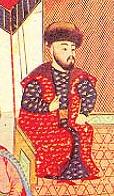Loading AI tools
From Wikipedia, the free encyclopedia
The Crimean Khanate was a state which existed in present-day southern Ukraine from 1441 until 1783. The position of Khan in Crimea was electoral and was picked by beys from four of the most noble families (also known as Qarachi beys: Argyns, Kipchaks, Shirins, and Baryns) at kurultai where the decision about a candidate was adopted.[2] The newly elected Khan was raised on a white felt sheet and over him were read Islamic prayers, after that the Khan was triumphantly enthroned.[2]
| Monarchy of Crimea | |
|---|---|
Trident of Giray | |
| Details | |
| First monarch | Hacı I Giray |
| Last monarch | Şahin Giray |
| Formation | 1441 |
| Abolition | 1783 |
| Residence | Bakhchisaray Palace |
| Appointer | Kurultai |
| Pretender(s) | Pamir Giray[1] Aleksei Guirey[1][dead link] |


The following is the chronological table of reigns of Khans of the Crimean Khanate from the Giray dynasty:
| Date of Reign | Name | Notes |
|---|---|---|
| 1441–1456 | Hacı I Giray[3] | first reign |
| 1456 | Haydar[3] | |
| 1456–1466 | Hacı I Giray[3] | second reign |
| 1466–1468 | Nur Devlet[3] | first reign |
| 1468–1474 | Meñli I Giray[3] | first reign |
| 1474–1475 | Nur Devlet[3] | second reign |
| 1475–1476 | Meñli I Giray[3] | second reign |
| 1476–1477 | dynasty dismissed from power[3] | |
| 1477 | Nur Devlet[3] | third reign |
| 1478–1514 | Meñli I Giray[3] | third reign |
| 1514–1523 | Mehmed I Giray[3] | |
| 1523–1524 | Ğazı I Giray[3] | |
| 1524–1532 | Saadet I Girai[3] | |
| 1532 | İslâm I Giray[3] | |
| 1532–1551 | Sahib I Giray[3] | |
| 1551–1577 | Devlet I Giray | |
| 1577–1584 | Mehmed II Giray | |
| 1584 | Saadet II Giray | |
| 1584–1588 | İslâm II Giray | |
| 1588–1596 | Ğazı II Giray | first reign |
| 1596 | Fetih I Giray | |
| 1596–1607 | Ğazı II Giray | second reign |
| 1607–1608 | Toqtamış Giray | |
| 1608–1610 | Selâmet I Giray | |
| 1610–1623 | Canibek Giray | first reign |
| 1623–1628 | Mehmed III Giray | † |
| 1628–1635 | Canibek Giray | second reign |
| 1635–1637 | İnayet Giray | |
| 1637–1641 | Bahadır I Giray | |
| 1641–1644 | Mehmed IV Giray | first reign |
| 1644–1654 | İslâm III Giray | |
| 1654–1666 | Mehmed IV Giray | second reign |
| 1666–1671 | Adil Giray | |
| 1671–1678 | Selim I Giray | first reign |
| 1678–1683 | Murad Giray | |
| 1683–1684 | Haci II Giray | |
| 1684–1691 | Selim I Giray | second reign |
| 1691 | Saadet III Giray | |
| 1691–1692 | Safa Giray | |
| 1692–1699 | Selim I Giray | third reign |
| 1699–1702 | Devlet II Giray | first reign |
| 1702–1704 | Selim I Giray | fourth reign |
| 1704–1707 | Ğazı III Giray | |
| 1707–1708 | Qaplan I Giray | first reign |
| 1709–1713 | Devlet II Giray | second reign |
| 1713–1715 | Qaplan I Giray | second reign |
| 1716–1717 | Devlet III Giray | |
| 1717–1724 | Saadet IV Giray | |
| 1724–1730 | Meñli II Giray | first reign |
| 1730–1736 | Qaplan I Giray | third reign |
| 1736–1737 | Fetih II Giray | |
| 1737–1740 | Meñli II Giray | second reign |
| 1740–1743 | Selamet II Giray | |
| 1743–1748 | Selim II Giray | |
| 1748–1756 | Arslan Giray | first reign |
| 1756–1758 | Halim Giray | |
| 1758–1764 | Qırım Giray | first reign |
| 1765–1767 | Selim III Giray | first reign |
| 1767 | Arslan Giray | second reign |
| 1767–1768 | Maqsud Giray | |
| 1768–1769 | Qırım Giray | second reign |
| 1769–1770 | Devlet IV Giray | first reign |
| 1770 | Qaplan II Giray | |
| 1770–1771 | Selim III Giray | second reign |
| 1771–1775 | Sahib II Giray | † |
| 1775–1777 | Devlet IV Giray | second reign |
| 1777–1782 | Şahin Giray | first reign |
| 1782 | Bahadır II Giray | |
| 1782–1783 | Şahin Giray | second reign |
| † The reigns of Canibek Giray in 1624 and of Maqsud Giray in 1771–1772 are not listed. Though these khans were formally appointed by Ottoman sultans they did not reach the throne and did not rule Crimea. In the years mentioned, the authority in the Crimean Khanate was exercised by Mehmed III Giray and Sahib II Giray correspondingly. | ||
Seamless Wikipedia browsing. On steroids.
Every time you click a link to Wikipedia, Wiktionary or Wikiquote in your browser's search results, it will show the modern Wikiwand interface.
Wikiwand extension is a five stars, simple, with minimum permission required to keep your browsing private, safe and transparent.